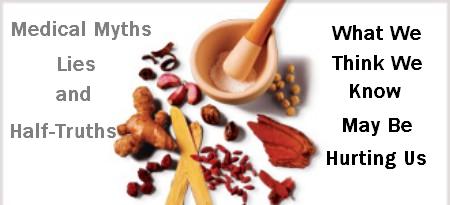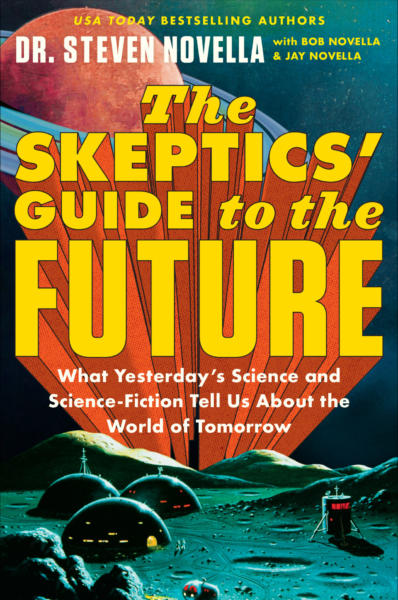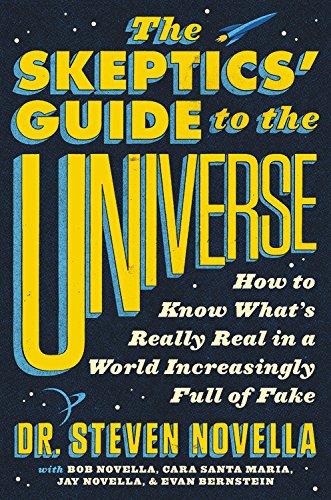Jan
31
2023
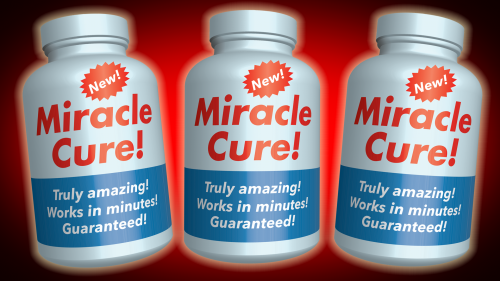 Some ideas never seem to die. There is something compelling about the narrative, perhaps because it fills some explanatory need. One of those narratives is that “they” have “the cure” to cancer but are keeping it hidden from the public in order to protect the profits that result from cancer treatment. I recently received the following e-mail (partly redacted):
Some ideas never seem to die. There is something compelling about the narrative, perhaps because it fills some explanatory need. One of those narratives is that “they” have “the cure” to cancer but are keeping it hidden from the public in order to protect the profits that result from cancer treatment. I recently received the following e-mail (partly redacted):
“I read many articles by physicians like yourself that claim secrets cannot be kept about cancer cures. I beg to differ.
Pharmaceutical firms require their associates to sign confidentiality agreements as a condition of employment. If they breach it, it’s safe to assume that they risk grave consequences for doing so.
These companies could care less about sick people. They only care about the health of their bottom line. They make far more profit on lifetime treatments rather than one-shot cures. After the patent expiration on a cure, the steady stream of revenue comes to a halt.
A cure eliminates the need for any new drug development unless the side effects are unpalatable. I was even told as much by a retired employee of a pharmaceutical company. She saw the private memos from their lobbyists.
In any case, the confidentiality contracts are why secrets are kept in the pharmaceutical industry. It’s also why cancer cures can be kept hidden as it would be treated as a trade secret. No one wants to be brought up on a felony charge of industrial espionage. Nor do they wish to be sued for it by their former employer.
Ask yourself the following question: would you risk your family’s future under those circumstances? No way! If you signed one of those legal instruments, you would never divulge such information if you came across it.”
The notion that a pharmaceutical company could hide a cancer cure is, in my opinion, and from the perspective of an academic physician who has participated in clinical research for pharmaceutical companies, hopelessly naive. The belief comes partly from looking into a complex system from the outside, without any real idea how it actually works. First let’s talk about the science and then we’ll turn to the logistics of the conspiracy itself.
Continue Reading »
Jan
30
2023
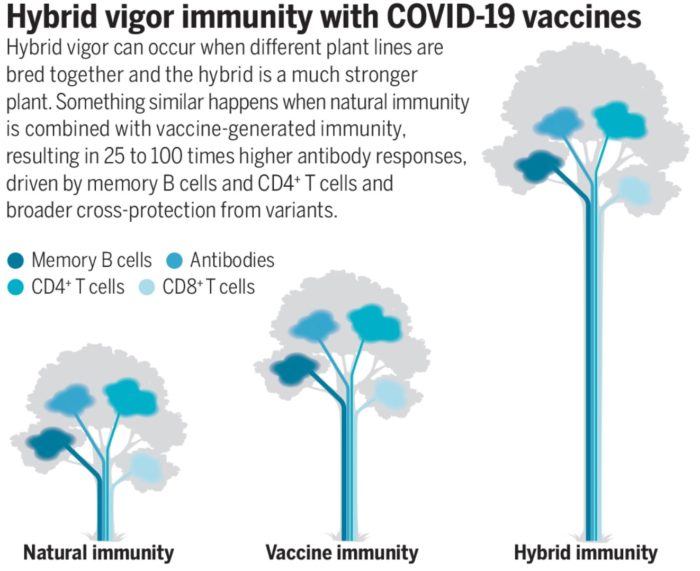 As many experts predicted, the COVID-19 pandemic is slowly sliding into an endemic infection. A pandemic is essentially when an epidemic goes worldwide. Endemic means that an infection is here to stay. It is no longer considered an “outbreak” but is constantly spreading around a population without having to be introduced. The flu, for example, is endemic, although it is also seasonal. Measles was endemic in the US, but then was eliminated through vaccination and was reduced to isolated outbreaks. However, it is transitioning to being endemic again because of vaccine hesitancy.
As many experts predicted, the COVID-19 pandemic is slowly sliding into an endemic infection. A pandemic is essentially when an epidemic goes worldwide. Endemic means that an infection is here to stay. It is no longer considered an “outbreak” but is constantly spreading around a population without having to be introduced. The flu, for example, is endemic, although it is also seasonal. Measles was endemic in the US, but then was eliminated through vaccination and was reduced to isolated outbreaks. However, it is transitioning to being endemic again because of vaccine hesitancy.
While we are all anxious for the COVID-19 pandemic to be over, I don’t remember any expert claiming that the virus would go away, or be eliminated to any significant degree. Rather, it would simply become like the flu, an endemic simmering infection that becomes part of the background. The only question has been – what is the best path to transition from pandemic to endemic? Some argued that perhaps the best path was to simply let the pandemic run its course, and create immunity through natural infection. This has always been an unscientific and dangerous suggestion, because that path leads through a maximum of disease and death.
The evidence clearly shows that the best path to minimizing COVID while ending its pandemic status was through a combination of vaccination and infection. We have no choice about the infection part because there is no plausible way to reduce it to zero (as China discovered). But we do want to reduce the spread of COVID, especially to vulnerable populations, while reducing the risk of serious illness, hospitalization and death through vaccination. Pandemics always eventually burn themselves out, even in the pre-vaccination era, but we don’t want that to happen from a plague-level decimation.
Evidence has been building that the best immunity from COVID is through hybrid immunity – a combination of vaccination and breakthrough infection. I managed to go two years without getting COVID, for example, but eventually succumbed once mask-wearing no longer became commonplace. However, by that time I had been fully vaccinated and boosted, so when I did get COVID it was indistinguishable from a fairly mild cold. If there weren’t a pandemic (and I didn’t test positive) I would have just thought I had a summer cold. Hybrid immunity works either way, whether you were infected then vaccinated, or vaccinated and then contracted COVID (the preferred order). Continue Reading »
Jan
19
2023

SBM will be hosting a viewing of a new documentary – Virulent: The Vaccine War. This will be followed by a Q&A with me, David Gorski, and the film producers. This is a virtual screening so you can watch it anytime between now and January 29th. The Q&A will start on Sunday, 1/29, at 7 pm.
Here is a link to the event page. We are asking for a donation of $12.50. This is an “early bird” rate, as on Tuesday, January 24, the price will increase to $15. Your donation will support grassroots screenings like this one to build awareness and demonstrate to public TV & educational distributors that there is an audience for the film.
For more more information, you can read the announcement on SBM.
Jan
10
2023
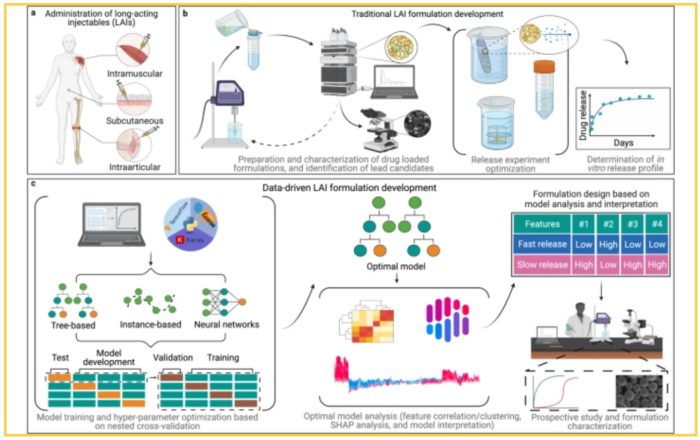 As a science communicator with a skeptical brand, I often have to walk a fine line. New scientific and technological developments can be amazing, but they are often surrounded by hype. I want to encourage enthusiasm for science, and I want to share the amazement and joy I experience following the latest discoveries. But it is very important to separate hype from reality, to temper our enthusiasm with realism, and to not get ahead of the science. It can be a very narrowly calibrated sweet-spot, one I have to consciously pay attention to.
As a science communicator with a skeptical brand, I often have to walk a fine line. New scientific and technological developments can be amazing, but they are often surrounded by hype. I want to encourage enthusiasm for science, and I want to share the amazement and joy I experience following the latest discoveries. But it is very important to separate hype from reality, to temper our enthusiasm with realism, and to not get ahead of the science. It can be a very narrowly calibrated sweet-spot, one I have to consciously pay attention to.
I have found it particularly challenging to hit this sweet spot with artificial intelligence (AI), especially recently. The past few years in particular have seen some amazing advances in AI applications, and in 2022, applications like DALLE-2, Midjourney, and ChatGPT showcased the power and disruptive potential of AI to the public. It’s hard to oversell how powerful these narrow AI applications can be, but at the same time it is easy to overhype them in other ways. I think it often comes down to this – people generally (even experts, historically) underestimate the potential of narrow AI (AI applications that have a specific function and are not conscious or have general intelligence). At the same time they tend to overestimate how soon we will see general AI, or they extrapolate linearly current AI advances into the future.
For example, with applications like Midjourney and ChatGPT, how far will applications like these go with extrapolations of current technology? They certainly will be better in 5 and 10 years, but will they transform into something truly creative? And does that even matter? Will these applications run into limits, or will they advance to be indistinguishable from human creators?
Meanwhile, programmers continue to show off the power and potential of current narrow AI technology, fueled by massive data sets and ever more powerful computers. Perhaps the most transformational applications are those running in the background of public consciousness, working to accelerate research and technological development. One area where AI is becoming particularly powerful is drug development.
Continue Reading »
Jan
05
2023
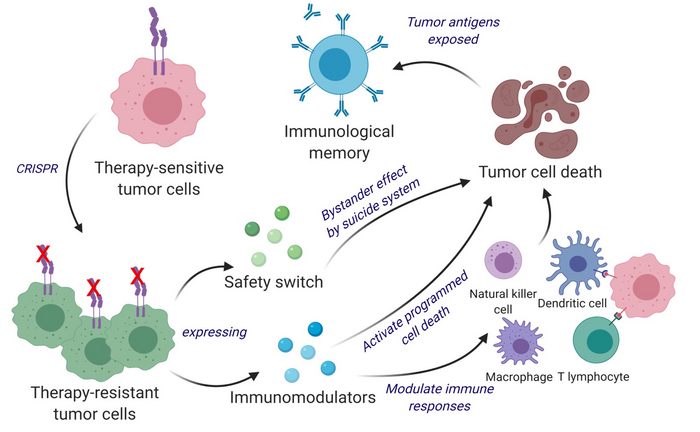 We are living in the future, at least the future I imagined 30 years ago when I was beginning my medical career. At the time I learned about a lot of new technologies that were only in the proof-of-concept or research phase, but there was a lot of enthusiasm about their potential. As often happens, translating those technologies into therapeutics took longer than we hoped, but now that they are hitting they are more powerful than we dreamed.
We are living in the future, at least the future I imagined 30 years ago when I was beginning my medical career. At the time I learned about a lot of new technologies that were only in the proof-of-concept or research phase, but there was a lot of enthusiasm about their potential. As often happens, translating those technologies into therapeutics took longer than we hoped, but now that they are hitting they are more powerful than we dreamed.
We now live in a world where there are monoclonal antibody therapeutics for many diseases, changing almost every field of medicine. We are starting to do real gene therapy to cure or mitigate genetic diseases. We have harnessed immune cells in order to target them against cancers. We are also at the beginning of hacking the brain with electrical and magnetic interventions to treat pain, seizures, movement disorders, and other conditions. These are all powerful approaches that are transforming medicine. They are not just incremental advances, such as developing a new drug, but entirely new methods of treatment that open up new possibilities.
I now read news items on a regular basis about such new treatments. One that caught my eye recently was just published in Science: Translational Medicine – Bifunctional cancer cell–based vaccine concomitantly drives direct tumor killing and antitumor immunity. This is a study in mice, so there are years of research before this approach hits the clinic, but it shows the potential of our existing technology.
Continue Reading »
Dec
22
2022
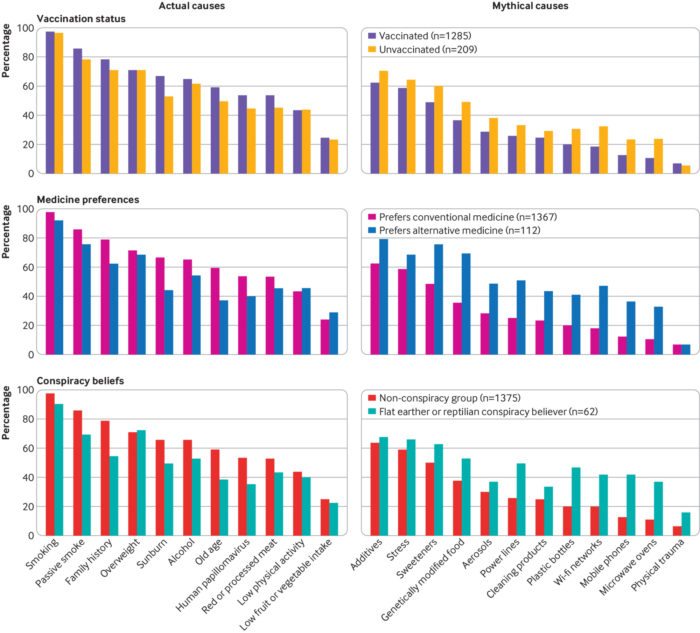 What are the known factors that increase the risk of getting cancer? Most people know about smoking, but can probably only guess at other factors, and are likely to endorse things that do not contribute to cancer risk. The known contributors to cancer risk include: smoking, consuming alcohol, low levels of physical activity, getting sunburnt as a child, family history of cancer, HPV infection, and being overweight. But there are also a number of “mythic” causes that do not contribute to cancer risk but are widely believed to: artificial sweeteners or additives and genetically modified food; using microwave ovens, aerosol containers, mobile phones, and cleaning products; living near power lines and feeling stressed.
What are the known factors that increase the risk of getting cancer? Most people know about smoking, but can probably only guess at other factors, and are likely to endorse things that do not contribute to cancer risk. The known contributors to cancer risk include: smoking, consuming alcohol, low levels of physical activity, getting sunburnt as a child, family history of cancer, HPV infection, and being overweight. But there are also a number of “mythic” causes that do not contribute to cancer risk but are widely believed to: artificial sweeteners or additives and genetically modified food; using microwave ovens, aerosol containers, mobile phones, and cleaning products; living near power lines and feeling stressed.
These are all lifestyle factors that people can influence by changing their behavior. Therefore there is a direct utility to informing the public about the true causes of cancer and identifying the factors that they should not worry about. I see the effects of misinformation and poor communication on a regular basis. Often my patients will express to me that they are highly motivated to get healthier by changing their lifestyle, and then they rattle off a list of things they are doing, most of which are useless or counterproductive. Forget all that – just stop smoking and let’s talk about a healthy and practical exercise routine for you.
A recent study seeks to shed light on why there is so much misinformation about the modifiable causes of cancer. This is a complex question, and any one study is only going to look at a tiny slice of potential contributing factors. Also, this is the type of question that is hard to look at in a controlled experiment, so we will have to make due with observational data that can have a lot of confounding factors. The authors did a survey of several English and Spanish language forums, assessing knowledge of true and mythic causes of cancer, and correlating them with belief in conspiracies, preference for alternative medicine, and lack of COVID-19 vaccination. The results are pretty much what you would expect, but let’s dive into some details.
Continue Reading »
Oct
20
2022
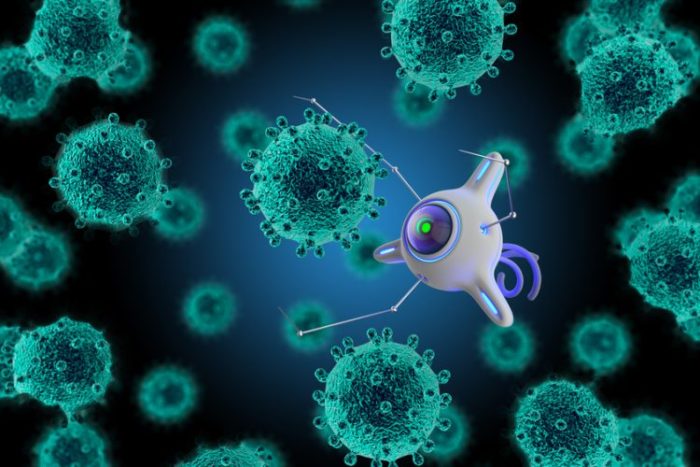 Imagine injecting microscopic robots into a patient that then can be guided to a specific location in the body where they deliver drugs or stem cells for therapy. This technology is actually not far off. Researchers have been developing multiple types of tiny medical robots, and some have been used successfully in animals.
Imagine injecting microscopic robots into a patient that then can be guided to a specific location in the body where they deliver drugs or stem cells for therapy. This technology is actually not far off. Researchers have been developing multiple types of tiny medical robots, and some have been used successfully in animals.
The simplest form of such microbots is a tiny sphere that contains magnetic nanoparticles and has a nanoscale structured surface. The surface allow for stem cells to bind so that they can be delivered to the desired location. The movement of the microbots is controlled by an external magnetic field acting on the nanoparticles. Essentially they are a delivery system, and when their task is done they are biodegradable so they break down and are eliminated by the usual mechanisms. Microbots can also be designed to be infused with drugs to deliver to their target.
There are numerous applications for this technology. One obvious one is the targeting of tumors. Effective anti-cancer treatments are often limited by their toxicity, but if they can be delivered directly to a tumor then they are both more effective and less toxic to healthy tissue. Stem cells can also be delivered, and they can also be engineered to kill cancer cells. They could also be engineered to produce hormones or chemical, or they could support other cells or even take up function themselves.
Other microbots can be self-propelled, including: “tailor-made motile bacteria and tiny bubble-propelled microengines to hybrid spermbots.” Another approach combines algae cells and nanoparticle to produce a microbot that can swim around specific organs, such as the lungs. This was tested in pneumonia in mice, and the microbots were able to swim around and kill the infecting bacteria.
Continue Reading »
Jul
29
2022
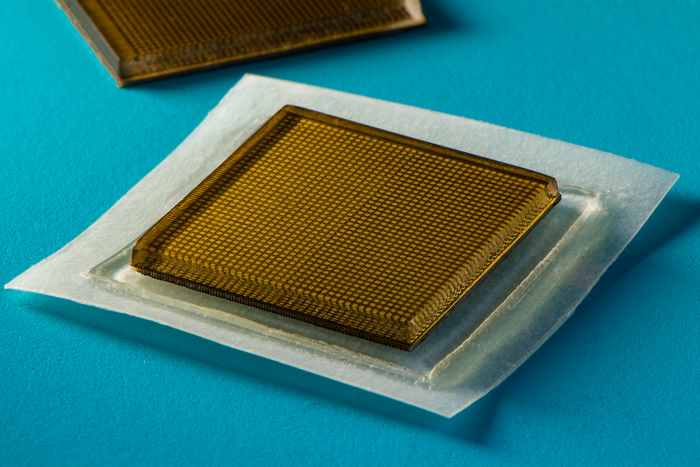 It’s easy to take for granted today the revolution in non-invasive medicine over the last century. Prior to the 20th century there was no blood testing to monitor health or diagnose disease. The first clinical use of X-rays was in 1896. The only way to peer into the body prior to that was with auscultation – listening to the sound various organs made, like heart sounds, the lungs breathing, and bowel sounds. Substances that came out of the body could also be examined. A physical examine could sometimes feel what was under the skin, not but deep or beneath bones. There was essentially very little that could be done to non-invasively examine what was happening inside the body. Surgery was the last resort – you had to open up the body and look inside if you needed to see.
It’s easy to take for granted today the revolution in non-invasive medicine over the last century. Prior to the 20th century there was no blood testing to monitor health or diagnose disease. The first clinical use of X-rays was in 1896. The only way to peer into the body prior to that was with auscultation – listening to the sound various organs made, like heart sounds, the lungs breathing, and bowel sounds. Substances that came out of the body could also be examined. A physical examine could sometimes feel what was under the skin, not but deep or beneath bones. There was essentially very little that could be done to non-invasively examine what was happening inside the body. Surgery was the last resort – you had to open up the body and look inside if you needed to see.
Today modern medicine has a long list of options, including using X-rays, magnetic fields, electrical signals, ultrasound, radioisotopes, and tiny cameras to non-invasively or minimally invasively look inside the body. This is all in the last century, a tiny slice of human history. We are also still on the steep part of the curve in terms of increasing our ability to diagnose and treat disease non-invasively. There are frequent incremental advances in the various technologies, and they are adding up over time.
One such incremental advance, which may expand the utility of an entire diagnostic technology, is wearable ultrasound. Ultrasound uses high frequency sound which is projected into the body, usually with a small hand-held probe which is pushed against the skin through a conducting gel. These sound waves bounce back and are picked up by the probe, which sends the information to a computer to construct an image. Anyone in a developed nation who has had a child since 1956 when the technology was first developed is likely familiar with this. Ultrasound is safe, minimally invasive, and can provide a wealth of useful data. It can examine more than fetuses, but can also look at heart function with sufficient detail to detect how the valves are working. It can examine blood vessels to look for clots, or to see if they are open and how they react to stimuli. Ultrasound can be used to look at other organs, to detect cysts or tumors, and to examine the lungs.
Continue Reading »
Jul
18
2022
 It is a frustrating reality that much of the cool technology we read about today will not be ready for widespread use for another 20-30 years. And of course not all such technology will pan out – but even when there is a high confidence level that they will, it will likely be decades before they change our lives. The cool technology I read about in popular science magazines in the 1980s didn’t really hit until the 2000s, and the advanced medical technology I learned about in medical school in the early 1990s didn’t mature until recently. So keep that in mind as I discuss this incremental advance in medical millirobots.
It is a frustrating reality that much of the cool technology we read about today will not be ready for widespread use for another 20-30 years. And of course not all such technology will pan out – but even when there is a high confidence level that they will, it will likely be decades before they change our lives. The cool technology I read about in popular science magazines in the 1980s didn’t really hit until the 2000s, and the advanced medical technology I learned about in medical school in the early 1990s didn’t mature until recently. So keep that in mind as I discuss this incremental advance in medical millirobots.
A millirobot is literally a millimeter size robot. The challenge of designing robots this small is to pack into that small size significant functionality. One method of getting such small robots to do stuff is origami technology – the robots can change their shape by folding and unfolding. Shape changing can accomplish specific tasks, such as locomotion, or package delivery. The advance here is to allow the millirobot to perform several tasks at once with the same origami feature, therefore packing more functionality into a tiny space.
Here we report a magnetically actuated amphibious origami millirobot that integrates capabilities of spinning-enabled multimodal locomotion, delivery of liquid medicine, and cargo transportation with wireless operation.
These tiny robots can therefore be controlled wirelessly. Further they can move both through liquid and over solid surfaces. And finally, the shape changing can deliver a liquid to a target destination. All of this is accomplished with the same origami feature, allowing for increased function while maintaining a small size.
Continue Reading »
Jul
05
2022
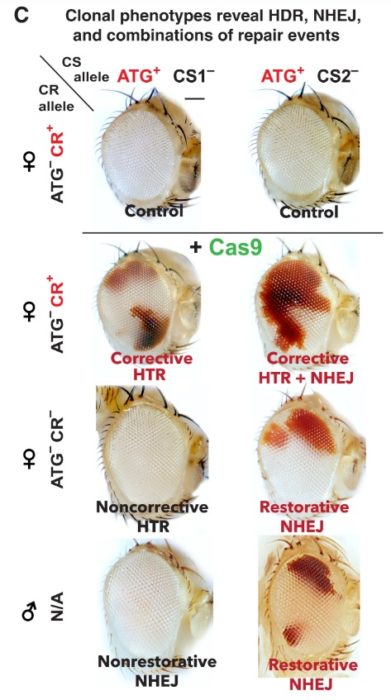 The technology of CRISPR (clustered regularly interspaced short palindromic repeat) continues to advance as a rapid pace. A recent study, Cas9/Nickase-induced allelic conversion by homologous chromosome-templated repair in Drosophila somatic cells, provides the potential for a new method of treating certain kinds of genetic diseases. This approach also appears to be safer, with fewer off-site genetic changes, but still has to be tested in humans.
The technology of CRISPR (clustered regularly interspaced short palindromic repeat) continues to advance as a rapid pace. A recent study, Cas9/Nickase-induced allelic conversion by homologous chromosome-templated repair in Drosophila somatic cells, provides the potential for a new method of treating certain kinds of genetic diseases. This approach also appears to be safer, with fewer off-site genetic changes, but still has to be tested in humans.
CRISPR works by pairing it with a guide RNA (gRNA) that targets a specific sequence in the DNA, and with a Cas9 endonuclease which will cleave the DNA at the target site. The normal DNA repair machinery will then fix the cut, but there are two basic pathways for this to happen. The first pathway (nonhomologous end joining – NHEJ) blindly reconnects the ends together, creating the potential for the introduction of random mutations at the repair site. This is considered an error-prone repair pathway. The other pathway is homology-directed repair (HDR), which uses the other copy of the DNA as a template, and is therefore much less prone to error. Remember, every cell has two of every somatic chromosome, one from each parent, and therefore two copies of every gene.
The researchers in the current study wanted to know if the HDR pathway could be exploited to not only repair the cleaved DNA but also to make the repaired copy of the gene look like the other copy, the “homologous” gene. Some genetic conditions or traits are dominant and others recessive. A dominant trait will manifest if an organism has only one copy of that trait, which a recessive trait requires that both copies of the gene have the trait. The classic example is eye color (this is an oversimplifcation, but demonstrates the point). Brown eye color is the dominant allele (gene version), while blue is recessive. A person with one brown and one blue allele will have brown eyes (dominant). You need two blue alleles to have blue eyes (recessive).
Continue Reading »
 Some ideas never seem to die. There is something compelling about the narrative, perhaps because it fills some explanatory need. One of those narratives is that “they” have “the cure” to cancer but are keeping it hidden from the public in order to protect the profits that result from cancer treatment. I recently received the following e-mail (partly redacted):
Some ideas never seem to die. There is something compelling about the narrative, perhaps because it fills some explanatory need. One of those narratives is that “they” have “the cure” to cancer but are keeping it hidden from the public in order to protect the profits that result from cancer treatment. I recently received the following e-mail (partly redacted):
 As many experts predicted, the COVID-19 pandemic is slowly sliding into an endemic infection. A pandemic is essentially when an epidemic goes worldwide. Endemic means that an infection is here to stay. It is no longer considered an “outbreak” but is constantly spreading around a population without having to be introduced. The flu, for example, is endemic, although it is also seasonal. Measles was endemic in the US, but then was eliminated through vaccination and was reduced to isolated outbreaks. However, it is transitioning to being endemic again because of vaccine hesitancy.
As many experts predicted, the COVID-19 pandemic is slowly sliding into an endemic infection. A pandemic is essentially when an epidemic goes worldwide. Endemic means that an infection is here to stay. It is no longer considered an “outbreak” but is constantly spreading around a population without having to be introduced. The flu, for example, is endemic, although it is also seasonal. Measles was endemic in the US, but then was eliminated through vaccination and was reduced to isolated outbreaks. However, it is transitioning to being endemic again because of vaccine hesitancy.
 As a science communicator with a skeptical brand, I often have to walk a fine line. New scientific and technological developments can be amazing, but they are often surrounded by hype. I want to encourage enthusiasm for science, and I want to share the amazement and joy I experience following the latest discoveries. But it is very important to separate hype from reality, to temper our enthusiasm with realism, and to not get ahead of the science. It can be a very narrowly calibrated sweet-spot, one I have to consciously pay attention to.
As a science communicator with a skeptical brand, I often have to walk a fine line. New scientific and technological developments can be amazing, but they are often surrounded by hype. I want to encourage enthusiasm for science, and I want to share the amazement and joy I experience following the latest discoveries. But it is very important to separate hype from reality, to temper our enthusiasm with realism, and to not get ahead of the science. It can be a very narrowly calibrated sweet-spot, one I have to consciously pay attention to. We are living in the future, at least the future I imagined 30 years ago when I was beginning my medical career. At the time I learned about a lot of new technologies that were only in the proof-of-concept or research phase, but there was a lot of enthusiasm about their potential. As often happens, translating those technologies into therapeutics took longer than we hoped, but now that they are hitting they are more powerful than we dreamed.
We are living in the future, at least the future I imagined 30 years ago when I was beginning my medical career. At the time I learned about a lot of new technologies that were only in the proof-of-concept or research phase, but there was a lot of enthusiasm about their potential. As often happens, translating those technologies into therapeutics took longer than we hoped, but now that they are hitting they are more powerful than we dreamed. What are the known factors that increase the risk of getting cancer? Most people know about smoking, but can probably only guess at other factors, and are likely to endorse things that do not contribute to cancer risk. The
What are the known factors that increase the risk of getting cancer? Most people know about smoking, but can probably only guess at other factors, and are likely to endorse things that do not contribute to cancer risk. The  Imagine injecting microscopic robots into a patient that then can be guided to a specific location in the body where they deliver drugs or stem cells for therapy. This technology is actually not far off. Researchers have been developing multiple types of tiny medical robots, and some have been used successfully in animals.
Imagine injecting microscopic robots into a patient that then can be guided to a specific location in the body where they deliver drugs or stem cells for therapy. This technology is actually not far off. Researchers have been developing multiple types of tiny medical robots, and some have been used successfully in animals. It’s easy to take for granted today the revolution in non-invasive medicine over the last century. Prior to the 20th century there was no blood testing to monitor health or diagnose disease. The
It’s easy to take for granted today the revolution in non-invasive medicine over the last century. Prior to the 20th century there was no blood testing to monitor health or diagnose disease. The  It is a frustrating reality that much of the cool technology we read about today will not be ready for widespread use for another 20-30 years. And of course not all such technology will pan out – but even when there is a high confidence level that they will, it will likely be decades before they change our lives. The cool technology I read about in popular science magazines in the 1980s didn’t really hit until the 2000s, and the advanced medical technology I learned about in medical school in the early 1990s didn’t mature until recently. So keep that in mind as I discuss
It is a frustrating reality that much of the cool technology we read about today will not be ready for widespread use for another 20-30 years. And of course not all such technology will pan out – but even when there is a high confidence level that they will, it will likely be decades before they change our lives. The cool technology I read about in popular science magazines in the 1980s didn’t really hit until the 2000s, and the advanced medical technology I learned about in medical school in the early 1990s didn’t mature until recently. So keep that in mind as I discuss  The technology of CRISPR (clustered regularly interspaced short palindromic repeat) continues to advance as a rapid pace. A recent study,
The technology of CRISPR (clustered regularly interspaced short palindromic repeat) continues to advance as a rapid pace. A recent study, 